Guy Moll Biography
He appeared on the starting grid quite suddenly as if dropped from the sky, this young man from French speaking Africa. His name was Guy Moll, but little else was known of him. The son of a French father and Spanish mother who had emigrated to Algeria, it was rumored that he had only started racing two years previous to showing up at the 1933 Grand Prix de Marseilles at Miramas, host to the 1926 French Grand Prix where he finished an astounding third. Brought there by Marcel Lehoux who in addition to having driven in and won several Grands Prix owned a large trade company in Algeria. 
For 1933 Moll ordered one of the latest Alfa Romeo 2300 Monzas. What followed was a series of podium finishes. Lehoux’s wasn’t the only eye he caught; Enzo Ferrari too saw something special. Signed to drive for the Scuderia in 1934 he promptly scored a win at the Grand Prix of Monaco. Ferrari would later remark that “…a debutant. His name was Guy Moll and he was showing that he belonged to the small group of top drivers. It is true that Moll was not the first foreigner that drove for me, but I acknowledge that he was the most sensational one. That day Moll showed his champion style, established his personality as driver and proved me right when choosing him for my team.”
In one short season he was not only challenging the best but beating them. Achille Varzi provided back-handed proof that the Algerian was making an impression when he was accused of having tried to force Moll off the road while the two “teammates” battled for the win in Tripoli. Moll would win again at the daunting Avusrennen driving an Alfa Romeo in streamlined configuration.

At the next race, Pescara, Moll, racing to re-take the lead from Fagioli met his end when he came upon the soon to be lapped Ernst Henne in a Mercedes, a full lap behind and having his first taste of real Grand Prix racing. His concentration broken Moll braked, lost control, nearly missed Henne, ran off the track, almost regained control but then ran into a ditch before finally coming to rest against a barn wall. The 24-year-old Algerian died shortly after the crash. Even when the powerful German cars were starting to eclipse the Italians, he was still able to race them on level terms when the conditions favored his astounding talent. He was giving proof of this in his last race.



















